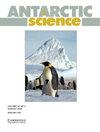First glaciological investigations at Ridge B, central East Antarctica
IF 2
4区 地球科学
Q3 ENVIRONMENTAL SCIENCES
引用次数: 3
Abstract
Abstract The region of Ridge B in central East Antarctica is one of the last unexplored parts of the continent and, at the same time, ranks among the most promising places to search for Earth's oldest ice. In January 2020, we carried out the first scientific traverse from Russia's Vostok Station to the topographical dome of Ridge B (Dome B, 3807 m above sea level, 79.02°S, 93.69°E). The glaciological programme included continuous snow-radar profiling and geodetic positioning along the traverse's route, installation of snow stakes, measurements of snow density, collection of samples for stable water isotope and chemical analyses and drilling of a 20 m firn core. The first results of the traverse show that the surface mass balance at Dome B (2.28 g cm−2 year−1) is among the lowest in Antarctica. The firn temperature below the layer of annual variations is −58.1 ± 0.2°C. A very low value of heavy water stable isotope content (-58.2‰ for oxygen-18) was discovered at a distance of 170 km from Vostok Station. This work is the first step towards a comprehensive reconnaissance study of the Ridge B area aimed at locating the best site for future deep drilling for the oldest Antarctic ice.南极东部中部山脊B的首次冰川学调查
摘要南极洲中东部的B脊地区是该大陆最后一个未经勘探的地区之一,同时也是寻找地球上最古老冰的最有希望的地方之一。2020年1月,我们进行了从俄罗斯沃斯托克站到B山脊地形圆顶(圆顶B,海拔3807米,79.02°s,93.69°E)的首次科学穿越。冰川学计划包括沿穿越路线的连续雪雷达剖面和大地测量定位、安装雪桩、测量雪密度,收集样品进行稳定的水同位素和化学分析,并钻探20米的冷杉岩心。导线测量的第一个结果表明,圆顶B(2.28 g cm−2年−1)的表面质量平衡是南极洲最低的。年变化层下的冷杉温度为−58.1±0.2°C。在距离沃斯托克站170公里处发现了一个非常低的重水稳定同位素含量值(氧-18为-58.2‰)。这项工作是对B脊地区进行全面勘察研究的第一步,旨在为未来最古老的南极冰的深度钻探定位最佳地点。
本文章由计算机程序翻译,如有差异,请以英文原文为准。
求助全文
约1分钟内获得全文
求助全文
来源期刊

Antarctic Science
地学-地球科学综合
CiteScore
3.60
自引率
6.20%
发文量
42
审稿时长
3 months
期刊介绍:
Antarctic Science provides a truly international forum for the broad spread of studies that increasingly characterise scientific research in the Antarctic. Whilst emphasising interdisciplinary work, the journal publishes papers from environmental management to biodiversity, from volcanoes to icebergs, and from oceanography to the upper atmosphere. No other journal covers such a wide range of Antarctic scientific studies. The journal attracts papers from all countries currently undertaking Antarctic research. It publishes both review and data papers with no limits on length, two-page short notes on technical developments and recent discoveries, and book reviews. These, together with an editorial discussing broader aspects of science, provide a rich and varied mixture of items to interest researchers in all areas of science. There are no page charges, or charges for colour, to authors publishing in the Journal. One issue each year is normally devoted to a specific theme or papers from a major meeting.
 求助内容:
求助内容: 应助结果提醒方式:
应助结果提醒方式:


